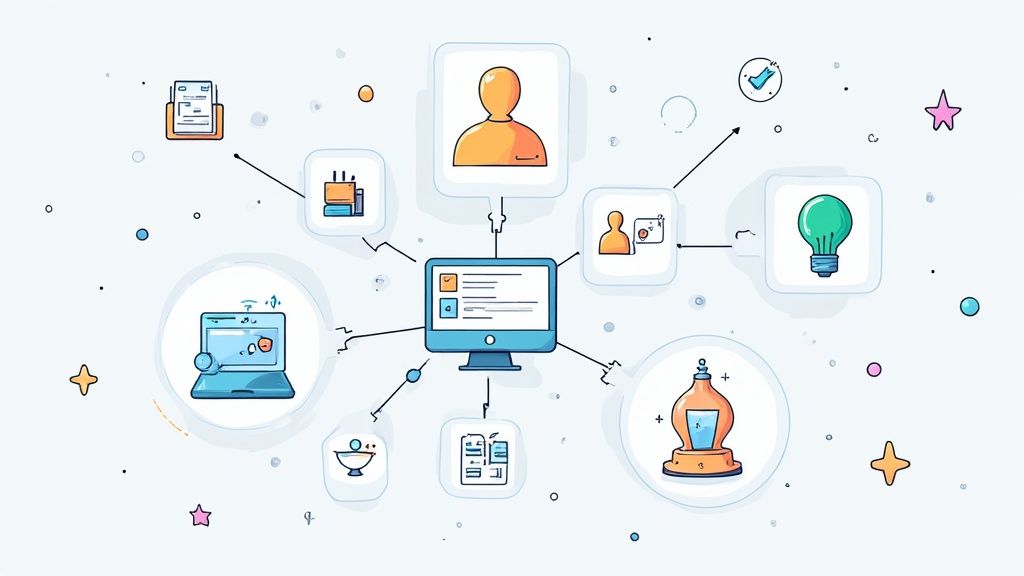Decoding Growth Strategy in Marketing

A growth strategy in marketing goes beyond simply acquiring new customers. It's about nurturing them throughout their entire journey with your brand. This involves understanding how to attract customers, keep them engaged, and encourage repeat business, ultimately fostering loyalty. This long-term approach differs significantly from traditional marketing, which often focuses on short-term gains from individual campaigns.
A successful growth strategy is built on a data-driven, experimental foundation. This framework allows businesses to adapt to the changing needs of their target audience. Understanding the importance of data is key to creating a truly effective growth marketing strategy.
Key Differences Between Traditional and Growth Marketing
One of the primary differences between traditional and growth marketing is their approach. Traditional marketing frequently operates in silos, concentrating on individual campaigns. Growth marketing, in contrast, prioritizes collaboration across all departments. This means aligning marketing with sales, product development, and customer service to create a unified and positive customer experience.
This integrated approach allows businesses to be more flexible and responsive to customer feedback. They can constantly refine their strategies based on real-time data and insights. For instance, if customer feedback highlights the need for a specific feature, the product team can be notified. Then, the marketing team can prepare to promote that feature effectively upon its release.
Growth marketing recognizes the importance of retention. While acquiring new customers is vital, retaining existing ones is often more cost-effective and builds long-term profitability. This focus on retention informs strategies that build lasting relationships with customers, creating loyalty and turning satisfied customers into brand advocates. Traditional marketing, on the other hand, may prioritize acquisition over long-term engagement. A growth strategy aims to create a sustainable system fueled by engaged and loyal customers.
The growth strategy in marketing is significantly impacted by the ever-evolving digital marketing landscape. By 2025, the global digital marketing market is predicted to reach $472.5 billion. It's expected to grow at a compound annual growth rate of 13.6%, reaching $1.3 trillion by 2033. This remarkable growth underscores the importance of strategic digital marketing tactics for business success. Companies are increasingly investing in paid media and new technologies, with more than 50% of marketing budgets allocated to these areas. Learn more about this growing market. This shift toward digital requires marketers to adapt, master new tools and techniques, and continually experiment to find what resonates most effectively with their audience.
Building Your Data-Driven Growth Engine

Moving from marketing based on gut feelings to a strategy driven by data is key for lasting success. This means understanding the metrics that truly make a difference and setting up systems to collect and understand them. It's not about vanity metrics; it's about the data that directly affects your bottom line.
Identifying Key Performance Indicators (KPIs)
The first step in building a data-driven growth engine is picking the right Key Performance Indicators (KPIs). These KPIs should match your overall business goals and offer useful information about customer behavior and how well your campaigns are performing.
For example, instead of just looking at website visits, concentrate on conversion rates, customer lifetime value, and churn rate. These metrics paint a more accurate picture of your marketing's effectiveness.
Additionally, create a clear process for gathering data. This could mean using analytics tools like Google Analytics, setting up tracking, and creating a regular reporting schedule. This ensures you have a reliable flow of data to guide your decisions. But just collecting data isn't enough; you also need to know how to interpret it.
Data Analysis and Interpretation
Analyzing data is the foundation of successful growth marketing. This involves looking beyond the numbers and digging into the reasons behind them. For instance, a high churn rate could point to problems with customer onboarding or how easy your product is to use. Finding these root causes is essential for creating effective solutions.
When assessing marketing campaigns, think about Return on Investment (ROI). As marketing budgets get tighter, showing a positive ROI is critical. In fact, 83% of marketing leaders now prioritize demonstrating ROI, up from 68% just five years ago. This move toward data-driven decisions also shows up in how budgets are allocated, with 64% of companies using past ROI data to plan future spending. You can find more detailed statistics here: https://www.firework.com/blog/marketing-roi-statistics. This highlights the importance of tracking and analyzing ROI as a core part of your growth plan.
To better understand the differences between traditional marketing metrics and growth-focused KPIs, let's examine the following comparison:
Key Growth Marketing Metrics Comparison
| Metric Type | Traditional Marketing | Growth Marketing | Impact on Strategy |
|---|---|---|---|
| Website Traffic | Pageviews, Unique Visitors | Conversion Rate, Bounce Rate | Shift from volume to engagement and quality of traffic |
| Lead Generation | Number of Leads | Lead Quality, Cost Per Lead | Focus on qualified leads that are more likely to convert |
| Brand Awareness | Impressions, Reach | Brand Sentiment, Share of Voice | Prioritize building a positive brand image and online presence |
| Customer Acquisition | Cost Per Acquisition (CPA) | Customer Lifetime Value (CLTV) | Emphasize long-term customer relationships and profitability |
This table illustrates the shift in focus from vanity metrics like website traffic and number of leads to more actionable metrics like conversion rate, lead quality, and customer lifetime value. Growth marketing emphasizes understanding the entire customer journey and optimizing for long-term growth.
Building a Culture of Experimentation
A data-driven growth strategy requires a culture of experimentation. This means regularly trying new things, analyzing the results, and making adjustments based on the data. This process of constant improvement keeps your marketing in sync with changing customer needs and market trends.
This ongoing refinement is vital for long-term growth and becoming a leader in your market. By embracing data, you can change your marketing from a cost center to a growth engine, delivering predictable and sustainable results.
Maximizing Digital Channels That Actually Perform
Successful marketing growth depends on choosing the right digital channels. It's not about chasing the latest trends. Instead, focus on platforms that truly connect with your audience and support your business goals. This creates a unified customer journey, not a fragmented one.
Identifying Your Optimal Channel Mix
The ideal channels for your business depend on several things: your target audience, your industry, and your growth objectives. For instance, a B2B company targeting professionals might find LinkedIn and industry forums more effective than Instagram. A B2C brand targeting a younger demographic might prioritize TikTok and Instagram.
-
Awareness: For building brand awareness, consider channels like social media, content marketing, and public relations.
-
Acquisition: To gain new customers, explore paid advertising, search engine optimization (SEO), and email marketing.
-
Retention: Boost customer retention with personalized email marketing, loyalty programs, and community building on platforms like Facebook Groups or Discord servers.
This focused approach ensures your resources are used effectively.
Content Development Across Platforms
Creating content that works well across different platforms takes strategy. Repurposing content can expand your reach efficiently. A blog post could become several social media updates, an infographic, or a short video. However, simply duplicating content across platforms is ineffective. Each platform has its own style and audience expectations.
Tailor your content to each platform's format and how users behave there. This might involve changing the tone, length, or visuals.
Measuring Cross-Channel Impact
Measuring the true impact of a multi-channel strategy means looking beyond individual metrics for each. Set up a system to track customer journeys across platforms. This could involve using UTM parameters in links to track traffic sources and conversions.
Analyze how different channels work together and influence one another. A customer might find your brand through a social media ad, visit your website, and buy something after getting an email. Understanding these interactions helps you optimize your channel mix and improve your overall return on investment (ROI). This comprehensive method helps you capture the true value of each channel. Focusing on the relationships between channels is essential for a successful marketing growth strategy.
Leveraging Influencer Partnerships That Drive Growth

Influencer marketing has become a crucial part of any successful marketing strategy. It's no longer a fleeting trend, but a powerful way to connect with your target audience. This is because authentic partnerships allow you to reach and engage customers in ways traditional advertising often can't. Identifying the right influencers is the first vital step.
Identifying and Approaching Potential Influencers
This process starts with understanding your ideal customer. Who are they following online? What kind of content do they enjoy? Answering these questions helps you find influencers whose audience matches your target market. A large following alone isn't enough. The audience must be relevant to your product or service.
For example, a fitness apparel company focused on Gen Z would likely partner with fitness influencers popular on TikTok and Instagram. They wouldn't necessarily partner with well-known figures on other platforms. This targeted approach ensures your message reaches the right people for maximum impact. Once you've identified potential influencers, a personalized approach is key.
Avoid generic outreach. Show genuine interest in the influencer's work. Explain why a partnership would be mutually beneficial. Highlight how your brand aligns with their values and content style. This helps build trust and increases the chances of a successful collaboration.
Building Authentic Partnerships
Authenticity is paramount in influencer marketing. Forced or inauthentic endorsements can harm both the influencer's credibility and your brand's reputation. Encourage influencers to integrate your product or service naturally into their content, showcasing its genuine value. This organic approach builds trust and encourages higher engagement.
Influencer marketing is a powerful strategy in today’s marketing world. The industry is predicted to reach $24 billion in 2024, showcasing its increasing influence. This growth comes from the trust and engagement influencers cultivate with their audience, often leading to higher conversion rates than traditional advertising. Micro-influencers, those with smaller but highly engaged followers, are especially effective for targeted and authentic promotion. For more statistics, check out this blog post on digital marketing statistics.
Compensation and Compliance
Various compensation models exist for influencer partnerships. These range from free products and affiliate commissions to fixed fees for posts or entire campaigns. The best model depends on the influencer’s reach, the campaign's scope, and your desired results. Transparency and clear agreements are essential for a smooth working relationship.
Legal and ethical considerations are just as important. Ensure compliance with advertising disclosure guidelines. Protect your brand by outlining expectations and responsibilities in a formal agreement. This safeguards both parties and maintains transparency with the audience. A well-defined marketing strategy recognizes the power of influencer partnerships and uses them strategically to achieve measurable results.
Integrating and Amplifying Influencer Content
Maximize the impact of influencer-generated content by integrating it into your broader marketing efforts. Share this content on your social media channels, embed it on your website, and use it in your email campaigns. This amplifies the message and extends its reach beyond the influencer’s immediate following.
By approaching influencer marketing strategically, prioritizing authenticity, and integrating it into your overall marketing plan, you can unlock its full potential to drive sustainable growth. This approach transforms influencers into valuable brand advocates, allowing for genuine connection with your target audience, building trust, and driving measurable results.
Transforming Retention Into Your Growth Superpower

Leading companies are shifting their focus from acquisition to customer retention. Nurturing existing relationships is proving to be a more effective growth strategy. This section explores why prioritizing existing customers often leads to a higher return on investment.
The Economics of Customer Loyalty
Acquiring new customers can be five to 25 times more expensive than retaining current ones. This significant cost difference highlights the financial benefits of focusing on customer loyalty.
Let's consider a software company with a subscription model. Investing in personalized onboarding and ongoing support for existing subscribers can be significantly more cost-effective than allocating resources to advertising campaigns aimed at attracting new users. A loyal customer base provides a consistent and predictable revenue stream.
To illustrate the financial impact of retention, let's take a look at the following table:
Customer Retention Economics: Statistical comparison of acquisition costs versus retention investments across industries
| Industry | Acquisition Cost | Retention Cost | ROI Difference | Loyalty Impact |
|---|---|---|---|---|
| Software | $500 | $100 | 400% | Increased subscriptions |
| E-commerce | $200 | $50 | 300% | Repeat purchases |
| Financial Services | $1000 | $200 | 400% | Higher customer lifetime value |
The table above showcases the substantial return on investment (ROI) difference between acquisition and retention efforts across various industries. This difference is directly correlated with the positive impact of customer loyalty on key business metrics like subscriptions, repeat purchases, and customer lifetime value.
Personalization That Matters
Effective personalization goes beyond simply using a customer's name. It requires understanding their specific needs and preferences. Gathering data through SurveyMonkey surveys, feedback forms, and analyzing in-app behavior is crucial for building a detailed customer profile. This information allows businesses to tailor messaging, offers, and product features to each individual.
-
Targeted Email Campaigns: Avoid generic emails. Instead, segment your audience based on past purchases, interests, or engagement levels and create tailored email content.
-
Customized Product Recommendations: By suggesting products or features aligned with individual user profiles, you can increase the likelihood of upsells and cross-sells.
-
Personalized Onboarding Experiences: Create customized onboarding flows that highlight the features most relevant to each new user's specific needs.
Building Loyalty Programs That Drive Behavior Change
Loyalty programs are not just about discounts. Effective programs reward customers for their continued engagement and cultivate a sense of community and exclusivity.
-
Tiered Rewards: Offer increasing benefits based on customer spending or engagement to encourage repeat business and strengthen loyalty.
-
Exclusive Access: Providing loyal customers with early access to new products, special promotions, or exclusive content strengthens their bond with your brand.
-
Community Building: Creating online forums or social media groups provides a platform for loyal customers to connect with each other and your brand, fostering a sense of belonging.
Enhancing Customer Experience
Building strong emotional connections with your customers is essential for long-term retention. This requires exceeding expectations with exceptional service and positive interactions at every touchpoint.
-
Proactive Customer Support: Anticipate and address potential issues before they escalate to demonstrate your commitment to customer success.
-
Personalized Communication: Use a conversational tone and address customers by name in all communications to build rapport and make them feel valued.
-
Feedback Integration: Actively solicit and incorporate customer feedback into product development, demonstrating that their opinions are valued and drive improvement.
By prioritizing customer retention through personalization, loyalty programs, and exceptional experiences, businesses can turn satisfied customers into brand advocates. These advocates will actively promote your brand and contribute to sustainable growth. This customer-centric approach is increasingly vital in competitive markets where strong customer relationships are key to success.
Implementing Your Growth Strategy Blueprint
Turning your growth strategy from a theoretical concept into a practical reality requires a structured approach. It's not just about choosing the right marketing tactics, but about assembling the right team and implementing effective processes. Think of your strategy as the blueprint and your team as the skilled construction crew – both are essential to bring your vision to life.
Structuring Your Growth Team
A high-performing growth team needs individuals who possess both creative thinking and analytical skills. This combination allows for innovative experimentation balanced by data-informed decision-making. Like a successful band, each member contributes unique talents to create a harmonious whole.
- Growth Lead/Manager: This person directs the team’s activities, ensuring everyone stays aligned with the overall growth strategy.
- Marketing Analysts: These data detectives are responsible for analyzing information, identifying trends, and measuring the success of various initiatives. They uncover hidden insights that drive strategic decisions.
- Content Creators: The storytellers of the team, Content Creators develop captivating material across different platforms to attract and engage potential customers. They are the voice of your brand.
- SEO/SEM Specialists: These architects of online visibility drive organic traffic and oversee paid advertising campaigns, ensuring your brand is seen by the right people.
- Email Marketers: The communicators who nurture relationships, Email Marketers create targeted email campaigns to cultivate leads and interact with existing customers.
Overcoming Common Roadblocks
Implementing a growth strategy isn't always smooth sailing. Challenges such as isolated departments and limited resources can arise.
Siloed Departments: Encourage collaboration between different teams by establishing shared objectives and promoting open communication. Breaking down these departmental barriers creates a more cohesive customer experience.
Resource Constraints: With limited budgets, it's crucial to prioritize high-impact projects and explore cost-effective tools and strategies. Smart prioritization can yield significant results even with limited resources.
Frameworks for Sustainable Experimentation
Continuous improvement hinges on consistent experimentation. This involves creating a structure that facilitates testing new concepts while mitigating risks.
- Develop a Hypothesis: Clearly articulate what you’re testing and your expected outcome. A well-defined hypothesis provides a clear direction for your experiment.
- Define Success Metrics: Identify the Key Performance Indicators (KPIs) you'll use to assess the impact of your experiment, allowing for objective evaluation.
- A/B Testing: A classic method for optimizing conversion rates, A/B testing involves comparing different variations of your marketing materials to determine which performs best.
- Analyze and Iterate: Examine the results of your experiments and utilize the insights gained to refine your strategy. This ongoing refinement is essential for long-term success.
Prioritization and Technology Investments
Prioritizing initiatives and investing in the appropriate technology are critical for maximizing your growth potential.
Prioritization: Methodologies such as the RICE scoring model (Reach, Impact, Confidence, and Effort) help focus efforts on high-impact, high-confidence projects requiring minimal effort. This ensures you're tackling the most important tasks first.
Technology Investments: Explore marketing automation tools, analytics platforms like Google Analytics, and CRM systems that can streamline your operations and offer valuable data. Strategic technology investments can significantly boost your growth efforts.
Action Plan for Scalable Growth
Transforming your marketing into a scalable growth engine necessitates a clear action plan.
- Define Your Target Audience: Understanding your ideal customer is essential for tailoring your messages and selecting appropriate channels.
- Develop a Content Strategy: Create valuable content that resonates with your target audience and caters to their needs throughout their customer journey.
- Optimize Your Website: Ensure your website is user-friendly, mobile-responsive, and optimized for conversions.
- Build an Email List: Gather email addresses and segment your audience to deliver personalized messages.
- Leverage Social Media: Connect with your target audience on the platforms they frequent.
Ready to harness the power of social proof in your marketing strategy? Notifyio.net provides expert insights and resources to enhance brand credibility and drive customer engagement. Visit Notifyio.net today and unlock the power of social proof.




Leave a Reply